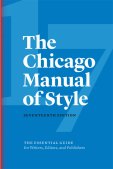 Although ideally you will cite more than one source in your research paper, there are times when a single source dominates, and you find yourself referring to it or quoting it repeatedly.
Although ideally you will cite more than one source in your research paper, there are times when a single source dominates, and you find yourself referring to it or quoting it repeatedly.
Does that mean you have to cite that source in full in a footnote (or endnote) every time?
Good news: you don’t! (Warning: some instructors might require you to cite in full every time, so be sure to ask before using any of these shortcuts.) There are several ways to cite a source repeatedly and save yourself some typing.
(Note: This post assumes you are using the notes-bibliography system. If you are using the author-date system, simply repeat the author and date in parentheses {(Rothfuss 2009)} every time, adding the page number you’re citing {(Rothfuss 2009, 32)}.)
1. Use a shortened form of the citation.
Let’s say you wrote a footnote (or endnote) for this book after you quoted from page 32:
8. Patrick Rothfuss, The Name of the Wind (New York, NY: DAW Books, 2009), 32.
The next time you cite that book (say, in note 12), you can give just the author’s last name, a shortened title, and the page number:
12. Rothfuss, Name of the Wind, 50.
If Name of the Wind is the only title by Rothfuss that you cite in your paper, you can leave out the title:
12. Rothfuss, 50.
This kind of shortening is recommended by The Chicago Manual of Style and Turabian’s Manual for Writers, but there are a couple of even faster ways to repeat a citation.
2. Cite the page number in the text.
Let’s go back to your first citation of The Name of the Wind, where you cited it in full:
8. Patrick Rothfuss, The Name of the Wind (New York, NY: DAW Books, 2009), 32.
If the next source you cite is this same book, you can simply put the new page number in parentheses in the text of your paper. You don’t have to write another note. Here’s a sample paragraph from a paper using this format:
Rothfuss uses the word innkeeper throughout The Name of the Wind.8 In some places, he uses it because he wants to avoid using the innkeeper’s name (50). In other places, he seems to use it just for variety (116, 310).
______
8. Patrick Rothfuss, The Name of the Wind (New York, NY: DAW Books, 2009), 32.
Important: Page numbers in parentheses in the text always refer to the most recently cited source. You can keep using page numbers in parentheses as long as you’re still citing that source. But as soon as you cite a different source, page numbers in the text will switch to the new source.
So let’s say you switch to citing passages from The Slow Regard of Silent Things. When you go back to citing The Name of the Wind, do you have to write out the whole citation again?
You don’t! You can continue to use the shortened author-title-page (or author-page) form shown in note 12 above.
Finally, for the truly lazy there is one more way to avoid typing out those titles.
3. Use an abbreviation.
This method is usually reserved for sources that recur many times. Let’s say your entire paper is about The Name of the Wind and you cite specific page numbers on practically every page. In that case, you can assign the book an abbreviation to use after the first full citation:
8. Patrick Rothfuss, The Name of the Wind (New York, NY: DAW Books, 2009), 32. Hereafter abbreviated NW.
You can then use the abbreviation any time you refer to the book, whether in the text of your paper or in another note, no matter how many sources you cite in between:
One example of this is the way Rothfuss uses the word innkeeper.8 In The Slow Regard of Silent Things, the word never appears.9 In Wind, he seems to use it just for variety (NW, 116, 310).
______
8. Patrick Rothfuss, The Name of the Wind (New York, NY: DAW Books, 2009), 32. Hereafter abbreviated NW.
9. Patrick Rothfuss, The Slow Regard of Silent Things (New York, NY: DAW Books, 2014).
Warning: Ask your instructor before using this method. (You knew that.)
4. Use ibid.
Many professional scholars use the Latin term ibid. to mean “the source I cited,” but Chicago prefers the use of a short citation. Teachers who want you to use ibid. will explain how, or you can read about it in the notes and bibliography chapter of The Chicago Manual of Style.
~ ~ ~
 #ChicagoStyle
#ChicagoStyle
Many libraries provide free access to The Chicago Manual of Style Online. If you aren’t sure whether your school subscribes, ask your librarian. In the meantime, click here for a free trial.
Order the hardcover here.
#ChicagoStyle for Students
 Kate Turabian’s A Manual for Writers of Research Papers, Theses, and Dissertations, written specifically for students, covers every aspect of research paper writing, from thinking up a topic to submitting the paper in official Chicago format. Turabian’s guidelines are compatible with The Chicago Manual of Style.
Kate Turabian’s A Manual for Writers of Research Papers, Theses, and Dissertations, written specifically for students, covers every aspect of research paper writing, from thinking up a topic to submitting the paper in official Chicago format. Turabian’s guidelines are compatible with The Chicago Manual of Style.
More advice for students
Please see our commenting policy.
 Although ideally you will cite more than one source in your research paper, there are times when a single source dominates, and you find yourself referring to it or quoting it repeatedly.
Although ideally you will cite more than one source in your research paper, there are times when a single source dominates, and you find yourself referring to it or quoting it repeatedly. #ChicagoStyle
#ChicagoStyle Kate Turabian’s A Manual for Writers of Research Papers, Theses, and Dissertations, written specifically for students, covers every aspect of research paper writing, from thinking up a topic to submitting the paper in official Chicago format. Turabian’s guidelines are compatible with The Chicago Manual of Style.
Kate Turabian’s A Manual for Writers of Research Papers, Theses, and Dissertations, written specifically for students, covers every aspect of research paper writing, from thinking up a topic to submitting the paper in official Chicago format. Turabian’s guidelines are compatible with The Chicago Manual of Style.

